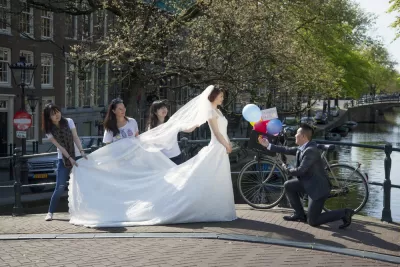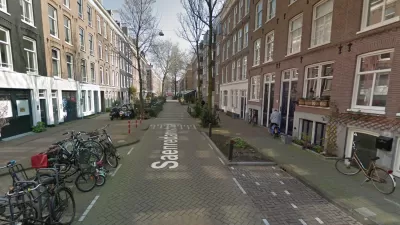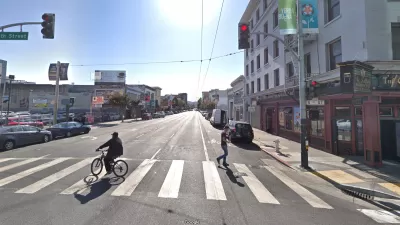Amsterdam will pursue the Oslo model of targeting parking spots, rather than driving bans, to make for a walk-and-bike friendly city. On-street parking spaces will gradually be replaced, starting July 1, with bike lanes, sidewalks, and trees.

Amsterdam isn't targeting actual parking spaces, but rather parking permits, required by motorists to park motor vehicles on the streets. Amsterdam will reduce parking permits in a new program that "strives for an accessible and livable city." Permits will also become more expensive.
"Amsterdam [deputy mayor] and transit commissioner Sharon Dijksma announced [March 28] that starting this summer, the city plans to reduce the number of people permitted to park in the city core by around 1,500 per year," reports Feargus O'Sullivan, who covers Europe for CityLab.
These people already require a permit to access a specific space (and the cost for that permit will also rise), and so by reducing these permits steadily in number, the city will also remove up to 11,200 parking spaces from its streets by the end of 2025.
The cleared spaces won’t be left empty, however. As room for cars is removed, it will be replaced by trees, bike parking, and wider sidewalks, allowing Amsterdammers to instantly see and feel the benefits of what will still be a fairly controversial policy among drivers.
Off-street parking won't be subject to the new program. In fact, new residents who apply for parking permits will be encouraged to find spaces in garages. "In total, there are 432,000 parking places in Amsterdam, of which 265,000 on the street and 167,000 in garages," according to Het Parool, an Amsterdam-based daily newspaper.
Existing residents need not fear to have their parking permits revoked, assuming they don't change residences. Instead, "the city will simply not replace any that are given up when drivers leave the city, give up their cars, or die," adds O'Sullivan. "In this way, the city reckons it can naturally do away with about 1,100 permits a year."
Currently, there are minimal wait periods for parking permits, writes Ruben Koops for Het Parool, "but due to the contraction, the waiting list will grow rapidly."
"The car remains part of this city, but its place is getting smaller," says Dijksma.
The parking permit reduction program is the result of the changes to the political landscape. "The city is currently being run by a coalition of left and centrist parties in which the Green Left party (GroenLinks) has the largest share," explains O'Sullivan. "A promise to reduce parking space formed part of the initial coalition agreement."
It also helps that elimination of parking spaces along the city's numerous canals brings major infrastructure benefits, adds O'Sullivan.
Many of the waterside streets and harbor quaysides in inner Amsterdam are in need of repair and renovation. Thanks to the delicate nature of Amsterdam’s subsoil, some of them actually need it pretty badly after groaning and buckling under the weight of cars for years.
"In the long term, Dijksma hopes that one of the major canals can be made car-free," adds Koops.
The Oslo approach
Jonathan Wolfe of The New York Times chronicled the shift in the car-free movement in Oslo, the capital and most populous city of Norway, from driving bans and toward parking removal, in addition to other strategies, posted here by Camille Fink on Dec. 25, 2018. See additional posts in Planetizen:
-
What Happens When a Downtown Becomes Nearly Car-Free? January 28, 2019
-
A Car Ban By Other Means, July 2, 2018
-
Oslo's Car-Free Dreams Easier Said Than Done, June 17, 2017
-
Pro-Walking, or Anti-Car? December 6, 2015
FULL STORY: A Modest Proposal to Eliminate 11,000 Urban Parking Spots

Study: Maui’s Plan to Convert Vacation Rentals to Long-Term Housing Could Cause Nearly $1 Billion Economic Loss
The plan would reduce visitor accommodation by 25,% resulting in 1,900 jobs lost.

North Texas Transit Leaders Tout Benefits of TOD for Growing Region
At a summit focused on transit-oriented development, policymakers discussed how North Texas’ expanded light rail system can serve as a tool for economic growth.

Why Should We Subsidize Public Transportation?
Many public transit agencies face financial stress due to rising costs, declining fare revenue, and declining subsidies. Transit advocates must provide a strong business case for increasing public transit funding.

How to Make US Trains Faster
Changes to boarding platforms and a switch to electric trains could improve U.S. passenger rail service without the added cost of high-speed rail.

Columbia’s Revitalized ‘Loop’ Is a Hub for Local Entrepreneurs
A focus on small businesses is helping a commercial corridor in Columbia, Missouri thrive.

Invasive Insect Threatens Minnesota’s Ash Forests
The Emerald Ash Borer is a rapidly spreading invasive pest threatening Minnesota’s ash trees, and homeowners are encouraged to plant diverse replacement species, avoid moving ash firewood, and monitor for signs of infestation.
Urban Design for Planners 1: Software Tools
This six-course series explores essential urban design concepts using open source software and equips planners with the tools they need to participate fully in the urban design process.
Planning for Universal Design
Learn the tools for implementing Universal Design in planning regulations.
Ascent Environmental
Borough of Carlisle
Institute for Housing and Urban Development Studies (IHS)
City of Grandview
Harvard GSD Executive Education
Toledo-Lucas County Plan Commissions
Salt Lake City
NYU Wagner Graduate School of Public Service




























